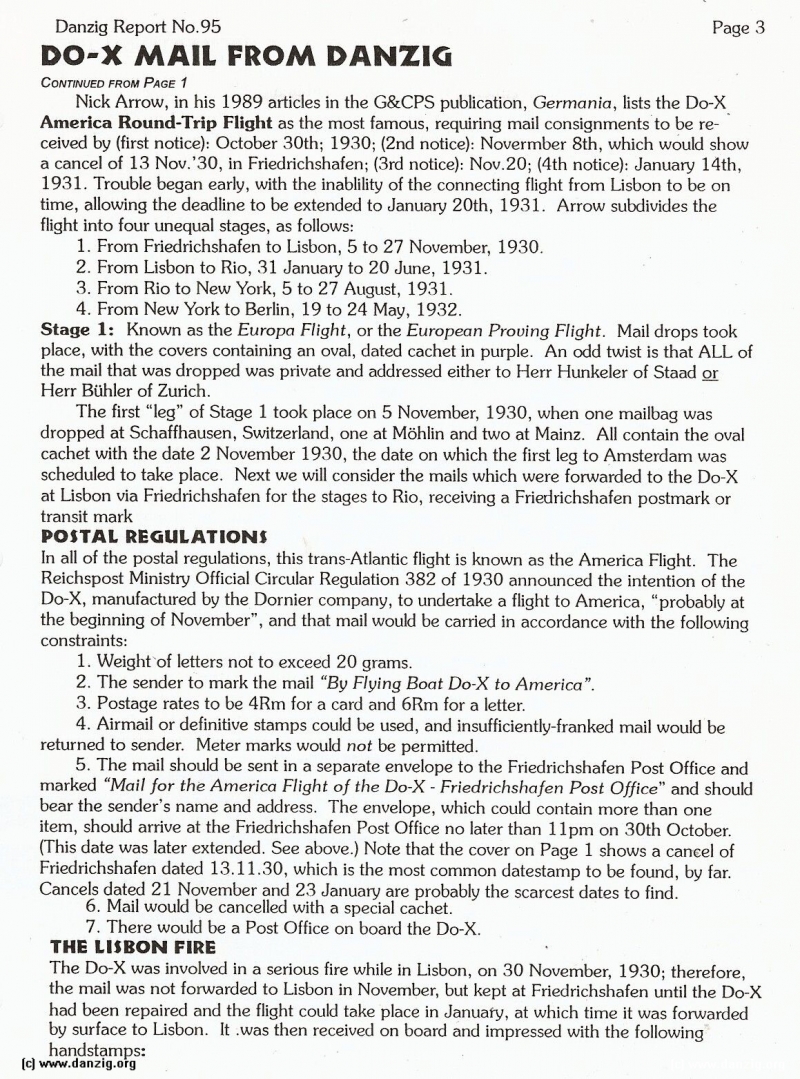
DO-X MAIL FROM DANZIG
CONTINUED FROM PAGE 1
Nick Arrow, in his 1989 articles in the G&CPS publication, Germania, lists the Do-X America Round-Trip Flight as the most famous, requiring mail consignments to be rec eived by (first notice): October 30th; 1930; (2nd notice): Novermber 8th, which would show a cancel of 13 Nov.’30, in Frledrichshafen; (3rd notice): Nov.20; (4th notice): January 14th, 1931. Trouble began early, with the inablility of the connecting flight from Lisbon to be on time, allowing the deadline to be extended to January 2 0th, 1931. Arrow subdivides the flight into four unequal stages, as follows:
1. From Friedrichshafen to Lisbon, 5 to 27 November, 1930.
2. From Lisbon to Rio, 31 January to 20 June, 1931.
3. From Rio to New York, 5 to 27 August, 1931.
4. From New York to Berlin, 19 to 24 May, 1932.
Stage 1: Known as the Europa Flight, or the European Proving Flight. Mail drops took place, with the covers containing an oval, dated cachet in purple. An odd twist is that ALL of the mail that was dropped was private and addressed either to Herr Hunkeler of Staad Herr Bühler of Zurich.
The first “leg” of Stage 1 took place on 5 November, 1930, when one mailbag was dropped at Schaffhausen, Switzerland, one at Möhlin and two at Mainz. All contain the oval cachet with the date 2 November 1930, the date on which the first leg to Amsterdam was scheduled to take place. Next we will consider the mails which were forwarded to the Do-X at Lisbon via Friedrichshafen for the stages to Rio, receiving a Friedrichshafen postmark or transit mark
POSTAL REGULATIONS
In all of the postal regulations, this trans-Atlantic flight is known as the America Flight. The Reichspost Ministry Official Circular Regulation 382 of 1930 announced the intention of the Do-X, manufactured by the Dornier company, to undertake a flight to America, “probably at the beginning of November”, and that mail would be carried in accordance with the following constraints:
1. Weight of letters not to exceed 20 grams.
2. The sender to mark the mail “By Flying Boat Do-X to America”.
3. Postage rates to be 4Rm for a card and 6Rm for a letter.
4. Airmail or definitive stamps could be used, and insufficiently-franked mail would be returned to sender. Meter marks would not be permitted.
5. The mail should be sent in a separate envelope to the Friedrichshafen Post Office and marked “Mail for the America Flight of the Do-X - Friedrichshafen Post Office” and should bear the sender’s name and address. The envelope, which could contain more than one item, should arrive at the Fnedrichshafen Post Office no later than 11pm on 30th October. (This date was later extended. See above.) Note that the cover on Page 1 shows a cancel of Friedrichshafen dated 13.11.30, which is the most common datestamp to be found, by far. Cancels dated 21 November and 23 January are probably the scarcest dates to find.
6. Mail would be cancelled with a special cachet.
7. There would be a Post Office on board the Do-X.
THE LISBON FIRE
The Do-X was involved in a serious fire while in Lisbon, on 30 November, 1930; therefore, the mail was not forwarded to Lisbon in November, but kept at Friedrichshafen until the Do-X had been repaired and the flight could take place in Januaty, at which time it was forwarded by surface to Lisbon. It .was then received on board and impressed with the following handstamps:
Danzig Report Vol. 1 - Nr. 95 - April - May - June - 1997, Page 3.
Hits: 3676
Added: 19/07/2015
Copyright: 2025 Danzig.org

